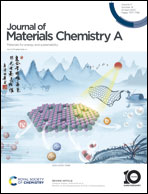Highly-efficient photocatalytic hydrogen evolution triggered by spatial confinement effects over co-crystal templated boron-doped carbon nitride hollow nanotubes†
Abstract
Conversion of solar energy into hydrogen energy through photocatalytic water splitting is vital for addressing the energy crisis problem and achieving carbon neutrality. Herein, boron-doped carbon nitride (BCN) hollow nanotubes have been successfully fabricated via a boric acid-assisted co-crystallization templating approach. The as-synthesized BCN hollow nanotubes with the optimal boron doping concentration show a significantly improved photocatalytic hydrogen evolution efficiency of 3.0658 mmol g−1 h−1, which is 7.2 times higher than that of the well-explored bulk C3N4. The electron density is redistributed as caused by electron-deficient boron dopants, leading to extended visible light capture and accelerated charge transport. The remarkable performance enhancement is attributed to the overall synergetic effects of the unique spatial confinement in hollow nanotubes and exceptionally modulated band structure. This work demonstrates an efficient strategy to enhance photocatalytic activity via synergetic morphology engineering and band structure engineering, which paves the way for engineering carbon nitride materials for energy and environmental catalysis applications.



 Please wait while we load your content...
Please wait while we load your content...